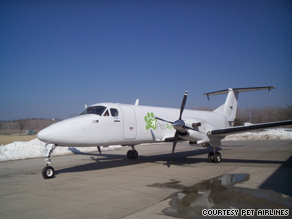By Stephanie Chen
CNN
(CNN) -- A few weeks ago, Tony Hoard, a 57-year-old manufacturing worker in Indiana, boarded a flight on Midwest Airlines to Las Vegas, Nevada, with his Australian Shepherd. The flight attendant smiled at the two and said, "Welcome aboard."

Midwest Airlines allows some of its canine customers to be seated in the cabin.
Hoard has flown with Rory, his furry 40-pound companion, in coach more than 15 times on Midwest, the Wisconsin-based airline that boasts "The Best Care in the Air." Each time they fly, Rory wears a harness and sits strapped into a seat.
"Rory gets the window seat," said Hoard, whose dog has won a series of Frisbee competitions. "He likes to look out the window when the plane takes off and naps the rest of the way."
Blame America's pet obsession, but in recent years, more members of the airline industry are embracing dogs and cats on board. Midwest Airlines may be an extreme example, letting select dogs sit in the same seats as humans, but other airlines are relaxing their pet policies by letting smaller cats and dogs come into the cabin area.
About a year ago, Midwest began allowing certain "celebrity" dogs that appear in canine competitions, shows or advertisements to sit in seats.
"They are just passengers with four legs instead of two," said Susan Kerwin, who oversees the pet program at Midwest Airlines.
The pet travel frenzy has spurred the creation of an airline catering exclusively to pets. This month, Pet Airways, the nation's first pet-only airline, will begin flying in five major cities, including New York and Los Angeles, California. It's an alternative to shipping larger pets in the cargo area of a plane, where there have been pet injuries and even deaths. Chart: Compare some of the common airline fees
"The owners can check a bag with them," explained Alyse Tognotti, a spokeswoman for Pet Airways. "Or if they have a special blanket or toy, basically anything that will take stress out of traveling."
On each Pet Airways flight, services include potty breaks and experienced animal handlers checking up on the animals every 15 minutes. Nervous parents can track their pets online.
Southwest Airlines was the latest airline to join the pet-loving bandwagon in May, when it permitted small dogs and cats to travel in the cabin area. The pets must sit in an approved kennel that fits under the seat.
"I wasn't going to fly Southwest Airlines," said Katie Chapman, 37, of Louisville, Kentucky, who is mom to a friendly 18-pound Cairn Terrier that resembles Toto from "The Wizard of Oz." Since the airline has changed its policy, she plans to take her puppy on a Southwest flight to California this fall. "I'm so glad now that she will be able to go with me."
Each year, airlines transport hundreds of thousands of pets in the cargo and cabin areas. Continental reported moving 270,000 pets last year in cabin and cargo, more than triple the number moved before the airline's pet program officially kicked off eight years ago.
The Federal Aviation Administration doesn't have restrictions on whether animals can be in the cabin area, but airlines must allow service dogs for the disabled on board. Only cats and dogs are allowed in the cabin areas on most airlines. In the cargo area, other pets like rabbits, birds and lizards can be stowed.
The cost of flying your furry friend ranges from $75 to nearly $300 each leg. It's a hefty price tag, but profit-bleeding airlines are happy to offer the option.
Pets can even rack up frequent flier miles. After three flights with Midwest, the pet can earn a fourth flight free. Continental and JetBlue Airways' programs credit the pet's trip on the owner's frequent flier account.
But one airline is catering to allergy-ridden customers who don't want pets in the cabin. Last year, Frontier Airlines banned pets from the cabin area because officials said pet allergies are common among their customers.
Ann Kerns, a 63-year-old teacher in Philadelphia, Pennsylvania, experienced continuous wheezing on a four-hour US Airways flight to Phoenix, Arizona. At the end of the flight, she was shocked to find that there had been a cat sitting under her seat.
"What would have happened if I went into an attack at 35,000 feet in the air?" she asked.
In 2008, the American College of Asthma, Allergy and Immunology wrote letters to Congress expressing concern about pets riding in the cabin area after some patients became ill from their flights. The letters didn't go very far, officials said.
Airlines say they have had few allergy injuries on board. The airlines limit the number of pets in the cargo area to about five. The aircraft is disinfected and cleaned routinely, so dander and hairs aren't a problem, airline officials say.
But not every traveler has had smooth experiences with pets on board.
Terry Trippler, a travel expert, recalls an unpleasant incident years ago when a dog had diarrhea three rows in front of him.
"You could certainly smell it," he wrote in an e-mail. "The only real way to solve the problem is no pets in the cabin."

No comments:
Post a Comment